

What Ancient Egyptian Sounded Like & How We Know It. If you’ve seen any Hollywood movie set in ancient Egypt, you already know how its language sounded: just like English, but spoken with a more formal diction and a range of broadly Middle-Eastern accents.
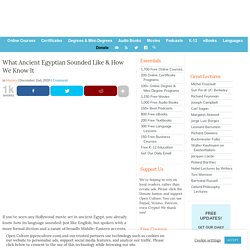
But then there are many competing theories about life that long ago, and perhaps you’d prefer to believe the linguistic-historical take provided in the video above. A production of Joshua Rudder’s NativLang, a Youtube channel previously featured here on Open Culture for its videos on ancient Latin and Chinese, it tells the story of “the many forms of the long-lived Egyptian languages,” as well as its “ancestors and relatives,” and how they’ve helped linguists determine just how the ancient Egyptians really spoke. Rudder begins with a certain artifact called — perhaps you’ve heard of it — the Rosetta Stone. Discovered in 1799 during Napoleon’s campaign in Egypt, it “bore two Egyptian scripts and, auspiciously, a rough translation in perfectly readable Greek.” Related Content: Digital Giza. Digital Resources for Teaching Ancient Egypt - Nile Scribes. As two newcomers to the teaching world, the Nile Scribes are interested in how they can apply digital humanities to their classrooms in the future.
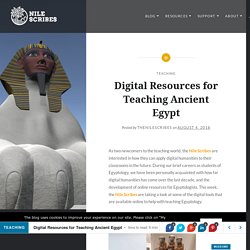
During our brief careers as students of Egyptology, we have been personally acquainted with how far digital humanities has come over the last decade, and the development of online resources for Egyptologists. This week, the Nile Scribes are taking a look at some of the digital tools that are available online to help with teaching Egyptology. 1. Describing Egypt Virtual tours to archaeological sites and museums with Egyptian collections have been on our mind for a long time. The high-quality photographs and ease of navigation allow the visitor a chance not only to look at the scenes in close detail, but also provide much-needed context for many of the reliefs we so often see in print as 2D representations. Tip: It works on your tablet device as well – try panning around with your finger and pinching to zoom. 2. 4. 5. 6.
Ancient Art Podcast. Welcome back to the Ancient Art Podcast, your guidebook to the art and culture of the ancient Mediterranean world and beyond.

I’m your friendly traveling companion, Lucas Livingston. A few weeks ago, I had the fantastic opportunity to travel to Egypt and Jordan as a study leader through the Art Institute of Chicago. It was a great trip and I met some wonderful people. A big shout out to our intrepid travel director K.C. for her tireless effort. What was life in Ancient Egypt like? 1) Who were the ‘ordinary people’?
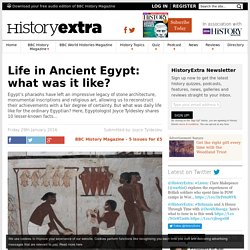
National Geographic. Egyptian Social Classes. When Rome Ruled Egypt. Best Ancient Egyptian Inventions - Fairmont Hotels. Cosmetics, Perfume, & Hygiene in Ancient Egypt. For the ancient Egyptians life was a celebration, and so, just as one would want to look one's best at any party, personal hygiene was an important cultural value.
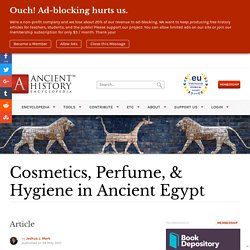
The Egyptians bathed daily, shaved their heads to prevent lice or other problems, and regularly used cosmetics, perfumes, and breath mints. So important was one's personal appearance that some spells from The Egyptian Book of the Dead stipulate that one cannot speak them in the afterlife if one is not clean and presentable, and it is clear this means in a physical sense.
Spell 125 prohibits one from speaking it unless one is "clean, dressed in fresh clothes, shod in white sandals, painted with eye-paint, anointed with the finest oil of myrrh. " Music & Dance in Ancient Egypt. Music and dance were highly valued in ancient Egyptian culture, but they were more important than is generally thought: they were integral to creation and communion with the gods and, further, were the human response to the gift of life and all the experiences of the human condition.
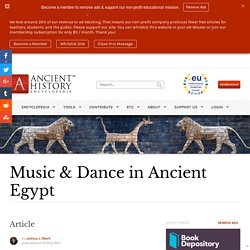
Egyptologist Helen Strudwick notes how, "music was everywhere in Ancient Egypt - at civil or funerary banquets, religious processions, military parades and even at work in the field" (416). The Egyptians loved music and included scenes of musical performances in tomb paintings and on temple walls, but valued the dance equally and represented its importance as well. The goddess Hathor, who also imbued the world with joy, was associated most closely with music, but initially, it was another deity named Merit (also given as Meret).
Ancient Egypt Sources - History Skills. Digital Egypt for Universities. Ancient Egypt on Flipboard. ETANA. Home - Vatican Museums. Digital Karnak: Welcome. The colossal site of Karnak is one of the largest temple complexes in the world, with an incredibly rich architectural, ritual, religious, economic, social and political history.
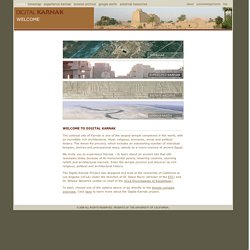
The Amun-Ra precinct, which includes an astonishing number of individual temples, shrines and processional ways, stands as a micro-cosmos of ancient Egypt. We invite you to experience Karnak – to learn about an ancient site that still resonates today because of its monumental pylons, towering columns, stunning reliefs and architectural marvels. A Short History of Ancient Egypt: Contents. Index. Click here to return to index of art historical sites.

Click here to return to index of artists and architects. Click here to return to chronological index. Click here to see the home page of Bluffton College. © 2001 Mary Ann Sullivan. I have photographed (on site), scanned, and manipulated all the images on these pages. Page maintained by Mary Ann Sullivan, sullivanm@bluffton.edu. Welcome to the British Museum. Internet History Sourcebooks. Internet Ancient History Sourcebook: Egypt See Main Page for a guide to all contents of all sections.

General MEGA Abzu: Guide to Resources for the Study of the Ancient Near East Available on the Internet [Website] MEGA Egyptology Resources [Website-Cambridge] WEB History of Ancient Egypt Page [At Charleston] WEB Neferchichi's ClipArt [Website] Images of divinities, and much more. Maps Chronologies There are myriad competing "high, middle, and low" chronologies for Egyptian history. See under Mesopotamia above for some links on these issues. Chronology of Egyptian History [At NWU] This is the chronology used here. St Andrews Corpus.
Costumes History in a Nutshell: Ancient Egypt. Ancient Egypt, like most major civilizations throughout history, was a class society.
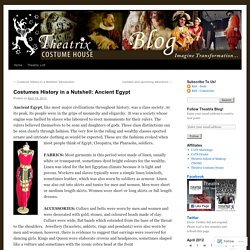
At its peak, its people were in the grips of monarchy and oligarchy. It was a society whose engine was fuelled by slaves who laboured to erect monuments for their rulers. The rulers believed themselves to be sons and daughters of gods. These class distinctions can be seen clearly through fashion. Amazing Art of Ancient Calendars. These ancient calendars are brilliant works of art, check them out and be amazed! The human race has a long way from living in caves in the strong age to planning to settle on different planets in this technologically advanced age. All this has become possible because of the curiosity of few intelligent individuals in the movement of astral bodies in the sky. They observed the movements of various planets in space night and day and chartered their path, speed and locations in the sky at different times for the posterity.
Over a period of time, such individuals came together, formed an association and started publishing their results for the knowledge of general public. Ancient Egyptian Fabrics and Clothing. Ancient Egyptian Clothing Textile and Dye Making The beginning of the arts of weaving and dyeing are lost in antiquity. Mummy cloths of varying degrees of fitness, still evidencing the dyer's skill, are preserved in many museums. The invention of royal purple was perhaps as early as 1600 B.C. Fringe Fashion. In pictures: the ancient Egyptian Book of the Dead at the British Museum. Pyramid Texts Online - English Translation. The following is the complete text from the Pyramid of Unas, based on translations by Faulkner, Piankoff and Speleer.
Use the links above to jump straight to the section of text you would like to read. At each section there is the opportunity to link to the corresponding section of the tomb. South Wall (west to east) Utterance 213 134: O Unas, you have not gone dead, you have gone alive to sit on the throne of Osiris. Mummification ("Good Riddance (Time of Your Life)" by Green Day) Why did ancient Egyptians wear wigs? Ancient Egypt. Map of Ancient Egypt Ancient Egypt as a general historical term broadly refers to the civilization of the Nile Valley between the First Cataract and the mouths of the Nile Delta, from circa 3300 B.C.E. until the conquest of Alexander the Great in 332 B.C.E.. As a civilization based on irrigation, it is the quintessential example of a hydraulic empire. It was one of the oldest, and the longest, human civilizations. Egypt has been a great source of inspiration and of interest for Europeans especially, who regard it as of almost mysterious significance.
Egypt served as a conduit between Europe and Africa. Egyptian civilization had a bias towards unity, rather than towards confrontation. Many Christians see deep significance that Jesus, according to tradition, spent time in Egypt. Civilization, Geography, & History. The First Construction Of Pyramid - Geographic History. Planet Egypt - Episode 1: Birth of the Empire (History Documentary) Ancient Egypt Sources - History Skills. Pharaoh's murder riddle solved after 3,000 years. "The cut is so very deep and quite large, it really goes down almost down to the bone (spine) - it must have been a lethal injury. " Internet History Sourcebooks. The Curse of Pharaoh Tutankhamun - Google Arts & Culture. The History of Egypt Podcast – The story of Egypt… from Creation to the Fall of Rome. 6 things you (probably) didn’t know about Cleopatra. 8 ancient Egyptian gods and goddesses that you (probably) didn’t know about.
1. History - Ancient History in depth: Ancient Egyptian Gods Gallery. History of Pyramids – Infographic. The Giza Pyramid Complex – Interactive Map – HeritageDaily. I have spent years documenting damage to Syria’s amazing cultural heritage. Ancient Egypt for Kids. Discover the Egyptians. Best Ancient Egypt Maps ~ Ancient Egypt Facts. Giza 3D - Dassault Systèmes. 3841 tombs and monuments listed. Thanks to 10 years of collected research, Dassault Systèmes was able to reconstruct the Giza Necropolis as accurately as possible.
Making an Ancient Egyptian Mummy.